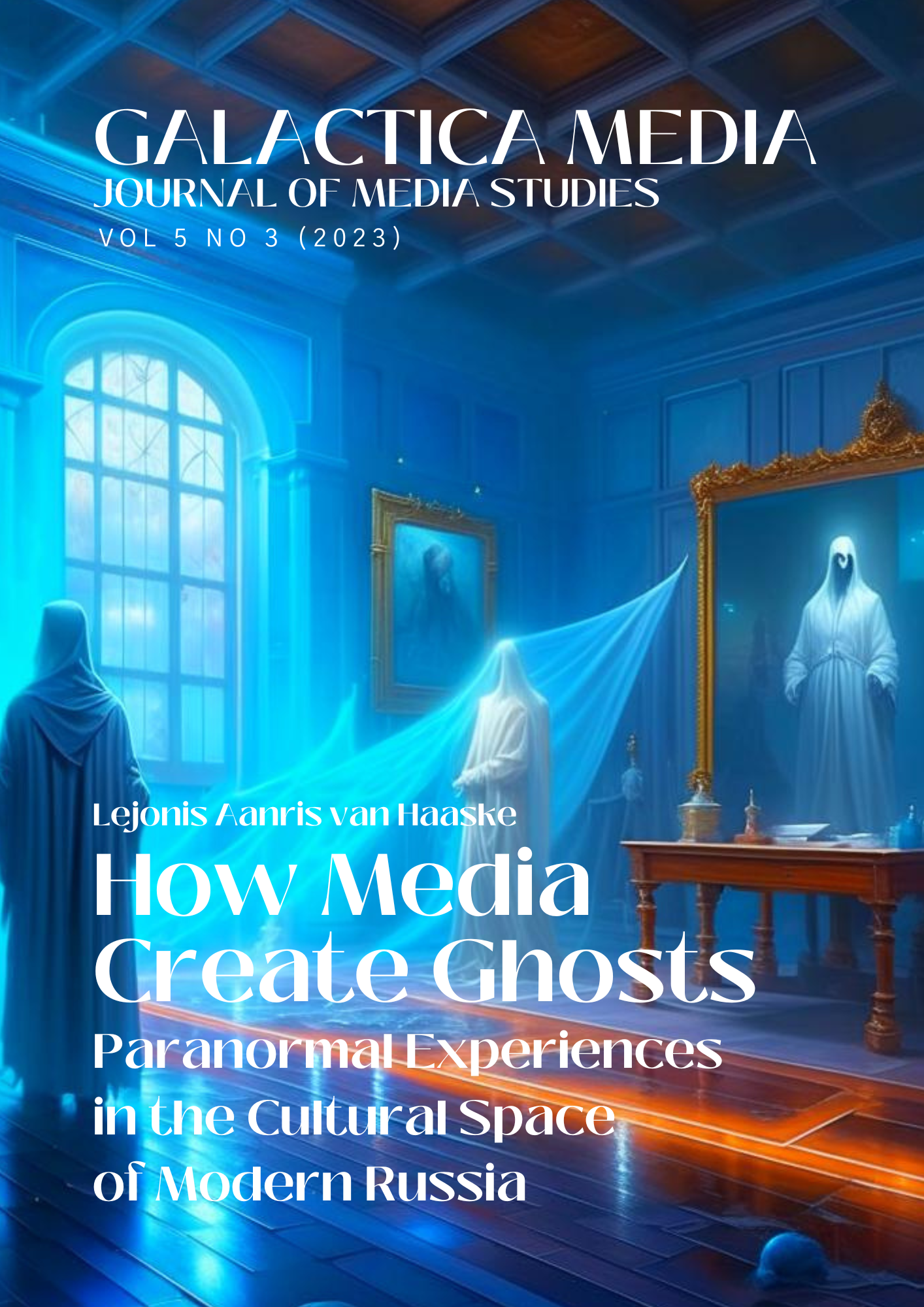Abstract
The subject of the article is the representation of ideas about the paranormal in the media. This issue is often brought up by psychologists, who directly point to the leading role of the media in the formation of such representations in present-day time. The author points out the kinship of research in the field of “paranormal psychology” with the studies of induced phenomena by Vladimir Bekhterev, who directly pointed out the role of mass media in the formation of induced ideas. The empirical part of the work consists in the analysis of a sample of media reports on the presence of ghosts, catalogued by the author. The main research question is how the features of the localization of the ghost phenomenon stated in the media can provoke its representation. The author concludes that the media are not only conductors of paranormal ideas, as noted by other researchers, but also partially demonstrate the causal relationships underlying the formation of paranormal ideas. The author underlines the close connection between a particular location, its history and the very report of paranormal phenomena in it. The author identifies the main descriptive techniques of the media associated with paranormal ideas, as well as shows the specifics of their distribution in the media environment. In fact, the article is intended to fill a kind of “information vacuum”, which has formed in the studies of ideas about the paranormal both in the Russian and foreign scientific environment, which makes this study very relevant.
References
Baker, J. O., & Bader, C. D. (2014). A social anthropology of ghosts in twenty-first-century America. Social Compass, 61(4), 569–593. https://doi.org/10.1177/0037768614547337
Baker, R. (1996). Hidden Memories: Voices and Visions from Within. Prometheus Books.
Bartholomew, R. E. (2001). Little green men, meowing nuns and head-hunting panics: A study of mass psychogenic illness and social delusion. McFarland.
Bechterev, V. M. (1908). Suggestion and Its Role in Public Life. K. L. Ricker’s Edition. (In Russian).
Bell, M. M. (1997). The ghosts of place. Theory and Society, 26(6), 813–836. https://doi.org/10.1023/A:1006888230610
Cardeña, E., Lynn, S. J., & Krippner, S. (2000). Varieties of anomalous experience: Examining the scientific evidence. American Psychological Association. https://doi.org/10.1037/10371-000
Edensor, T. (2005). The ghosts of industrial ruins: Ordering and disordering memory in excessive space. Environment and Planning d: Society and Space, 23(6), 829–849. https://doi.org/10.1068/d58j
Ellis, B. (2000). Aliens, Ghosts, and Cults: Legends We Live. University Press of Mississippi.
Ellis, B. (2014). Raising the devil: Satanism, new religions, and the media. University Press of Kentucky.
French, C. C., & Stone, A. (2013). Anomalistic Psychology: Exploring Paranormal Belief and Experience. Red Globe Press.
Gordon, A. (1997). Ghostly Matters: Haunting and the sociological imagination. University of Minnesota Press.
Guerin, B., & Miyazaki, Y. (2006). Analyzing rumors, gossip, and urban legends through their conversational properties. The Psychological Record, 56(1), 23–33. https://doi.org/10.1007/BF03395535
Hankey, R. (1942). California ghosts. California Folklore Quarterly, 1(2), 155–177. https://doi.org/10.2307/1495482
Holloway, J., & Kneale, J. (2008). Locating haunting: A ghost-hunter’s guide. Cultural Geographies, 15(3), 297–312. https://doi.org/10.1177/1474474008091329
Inglis, D., & Holmes, M. (2003). Highland and other haunts: Ghosts in Scottish tourism. Annals of Tourism Research, 30(1), 50–63. https://doi.org/10.1016/S0160-7383(02)00031-2
Irwin, H. J. (2009). The psychology of paranormal belief: A researcher’s handbook. University of Hertfordshire Press.
Jones, L. C. (1944). The ghosts of New York: An analytical study. The Journal of American Folklore, 57(226), 237–254. https://doi.org/10.2307/535356
Klemperer, F. (1992). Ghosts, visions, and voices. British Medical Journal, 305(6868), 1518. https://doi.org/10.1136/bmj.305.6868.1518
Kozhevnikov, N. S. (2020). Cemetery as a Sociocultural Space. In Sociology and Society: Traditions and Innovations in the Social Development of Regions (pp. 3435–3445). Russian Society of Sociologists. https://doi.org/10.19181/kongress.2020.409 (In Russian).
Kulikova, D. L. (2021). Mythopoetics of Cemetery Space in Horror (Based on Contemporary Russian Literature). Perm University Herald. Russian and Foreign Philology, 13(23), 86–93. https://doi.org/10.17072/2073-6681-2021-3-86-93 (In Russian).
Ladd, B. (1997). The Ghosts of Berlin. Chicago University Press. https://doi.org/10.7208/chicago/9780226467603.001.0001
Lange, R., & Houran, J. (1997). Context-induced paranormal experiences: Support for Houran and Lange’s model of haunting phenomena. Perceptual and Motor Skills, 84, 1455–1458. https://doi.org/10.2466/pms.1997.84.3c.1455
Leudar, I., & Thomas, P. (2005). Voices of reason, voices of insanity: Studies of verbal hallucinations. Routledge. https://doi.org/10.4324/9780203977583
Marks, D. F. (1988). The psychology of paranormal beliefs. Experientia, 44(4), 332–337. https://doi.org/10.1007/BF01961272
McCorristine, S. (2010). Spectres of the Self: Thinking about Ghosts and Ghost-seeing in England, 1750‑1920. Cambridge University Press. https://doi.org/10.1017/CBO9780511779749
Nazarov, M. M. (2004). Mass Communication and Society. Avanta Plus. (In Russian).
Pile, S. (2005). Real cities: Modernity, space and the phantasmagorias of city life. Sage. https://doi.org/10.4135/9781446220665
Pile, S. (2017). Spectral cities: Where the repressed returns and other short stories. In Habitus: A sense of place (pp. 251–273). Routledge.
Preece, P. F., & Baxter, J. H. (2000). Scepticism and gullibility: The superstitious and pseudo-scientific beliefs of secondary school students. International Journal of Science Education, 22(11), 1147‑1156. https://doi.org/10.1080/09500690050166724
Smirnov, Y. A. (2016). Urban Legends and Monastery Cemeteries. Living Antiquity, 3(91), 60–62. (In Russian).
Sperber, D. (1990). The epidemiology of beliefs. Clarendon Press.
Van Haaske, L. A. (2014). Images of Fear of the Supernatural in the Mythological Tradition of High Medieval Europe. Bulletin of the Moscow State Humanitarian University Named after M.A. Sholokhov. History and Political Science, 3, 54–62. (In Russian).
Van Haaske, L. A. (2021). Constructing the Supernatural in the Media: Chronomirage as a Specific Form of Cultural Memory. In Current Issues in Media Studies-2021 (pp. 87–89). Faculty of Journalism, Moscow State University. (In Russian).
Volkov, A. B. (2014). Ghosts of Russian Estates. Veche. (In Russian).
Vorobieva, M. V. (2020). Recreation Cemeteries: Culture of Remembrance and Politics of Memory in the Parks of the Middle Urals. Discourse-P, 4, 68–85. https://doi.org/10.24411/1817-9568-2020-10405 (In Russian).
Wiseman, R., Watt, C., Stevens, P., Greening, E., & O’Keeffe, C. (2003). An investigation into alleged ‘hauntings’. British Journal of Psychology, 94(2), 195–211. https://doi.org/10.1348/000712603321661886
Zelenin, D. K. (2021). Sketches of Slavic Mythology. Veche. (In Russian).

This work is licensed under a Creative Commons Attribution 4.0 International License.


